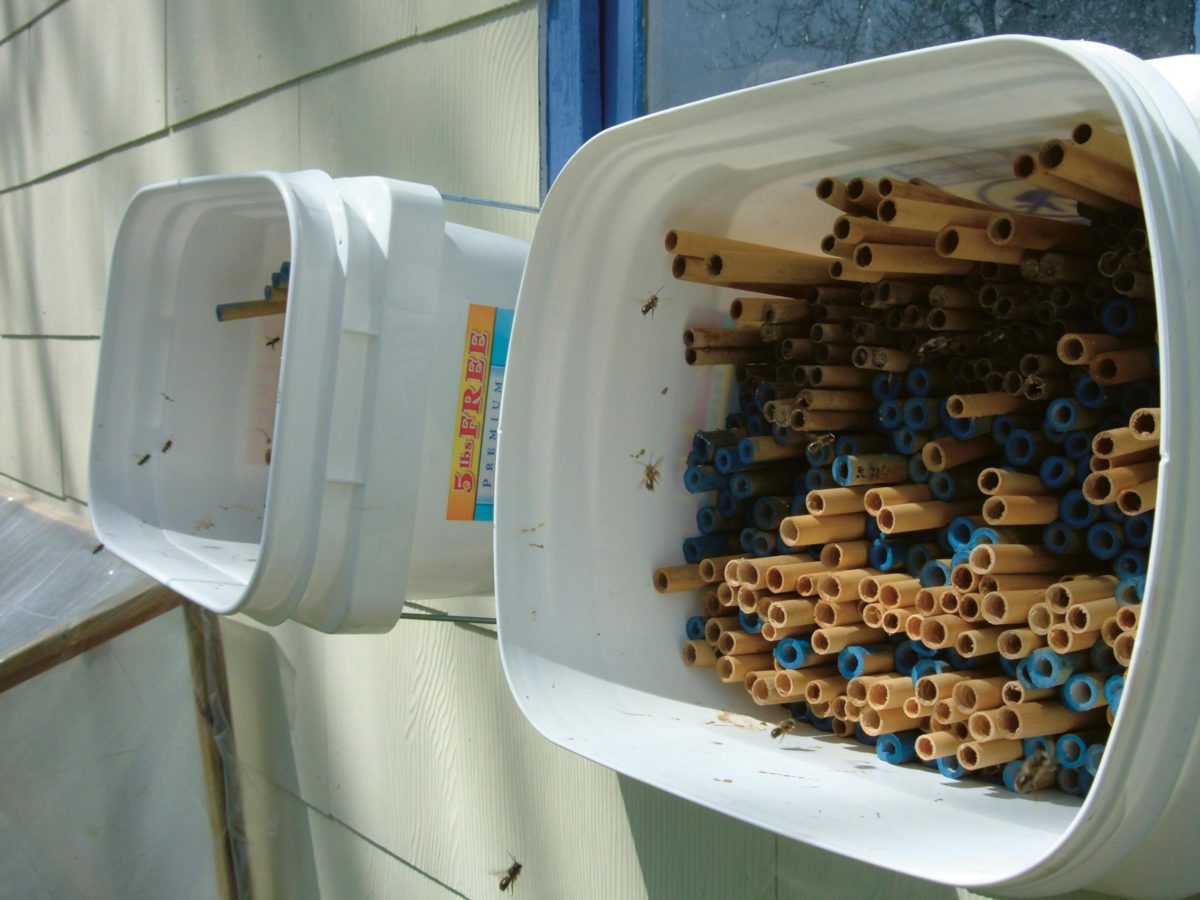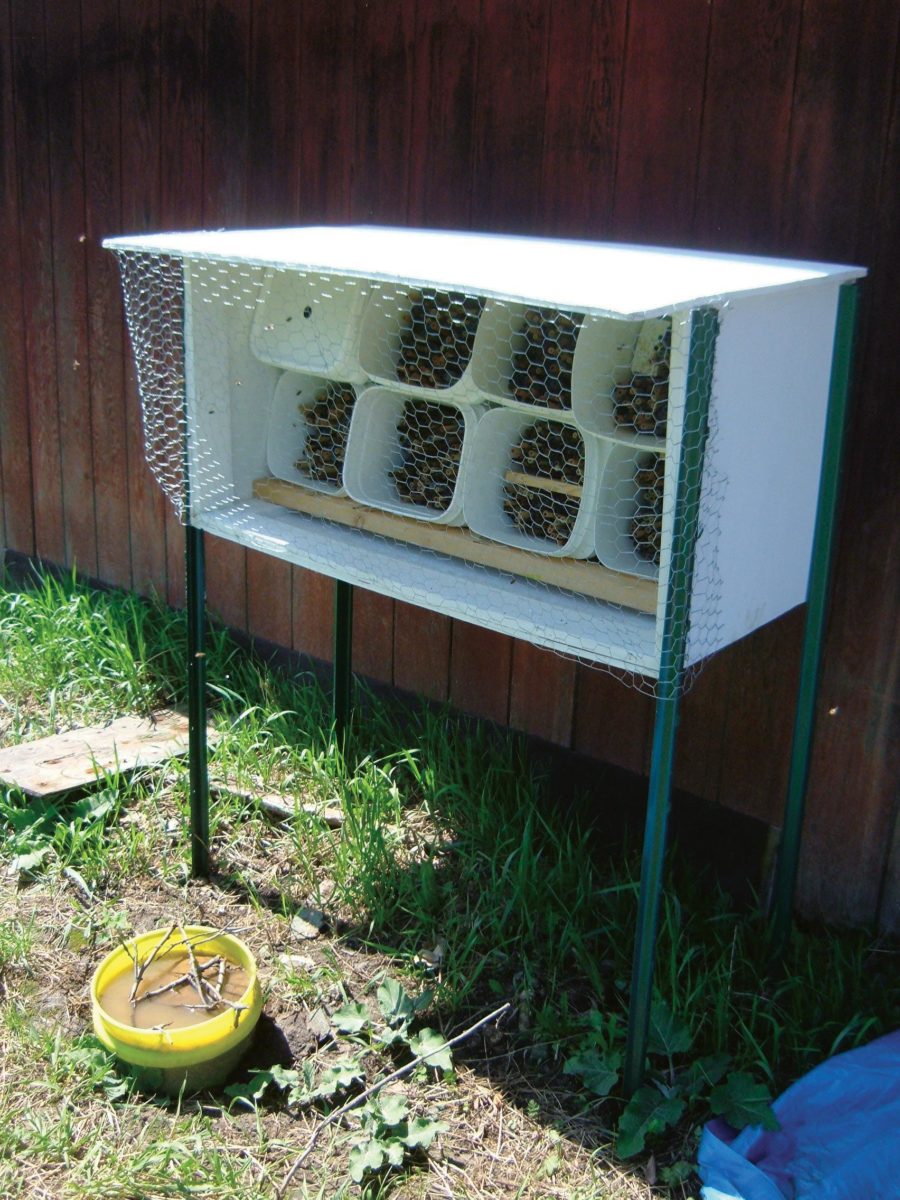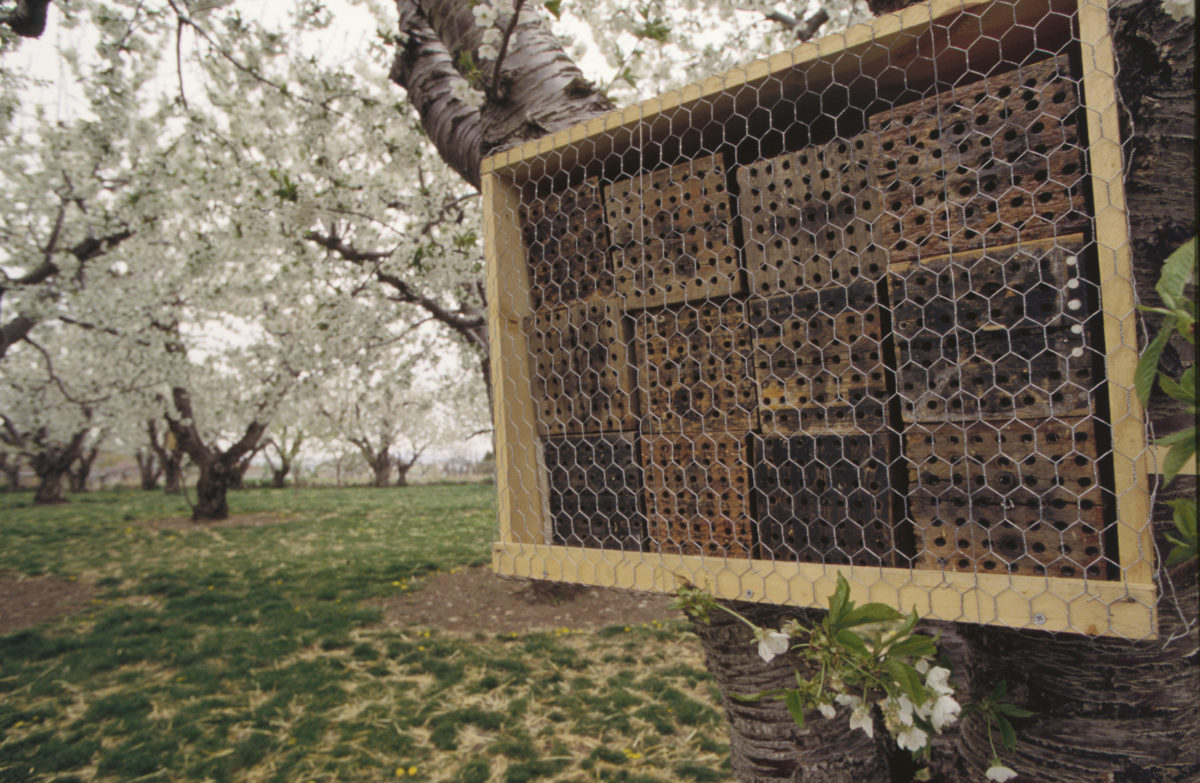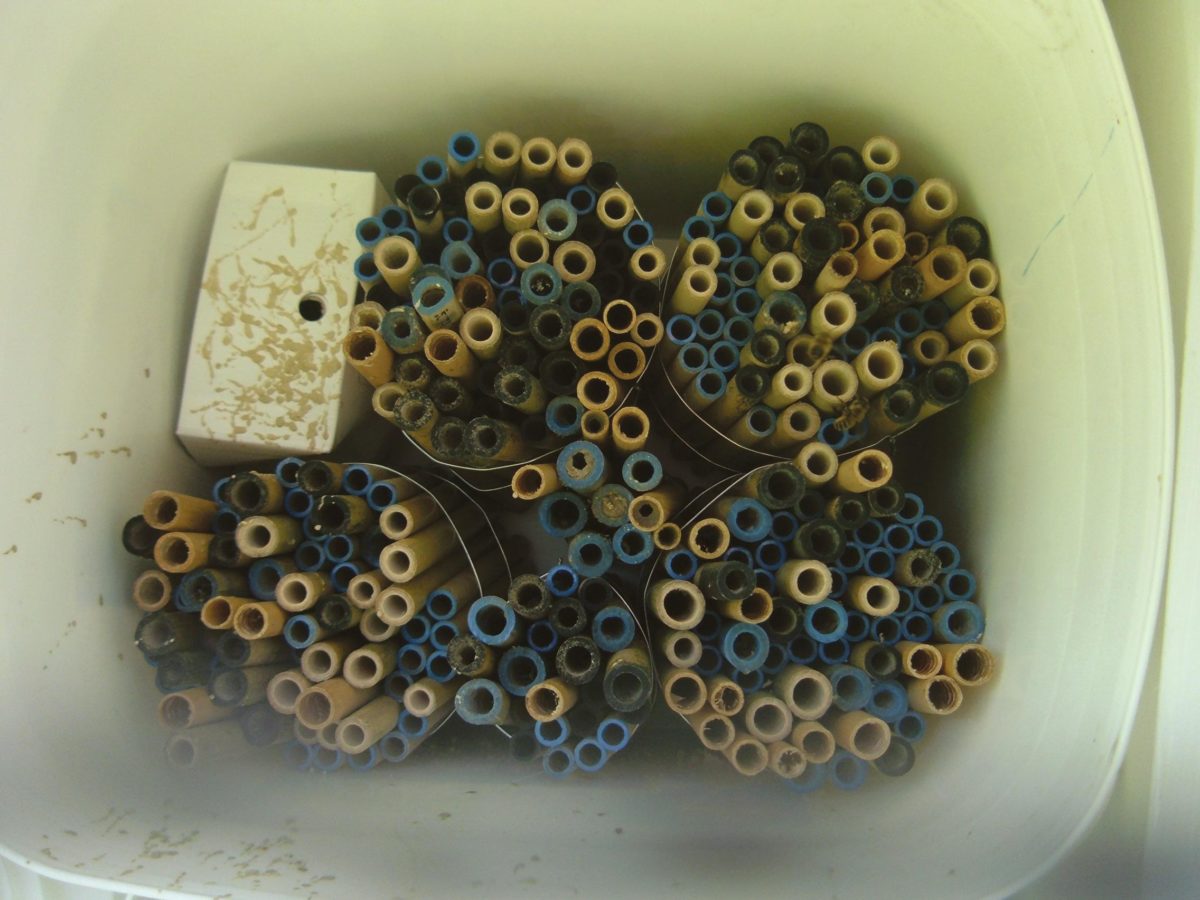A common way of obtaining mason bees is by trapnesting wild populations. Trap nests are set out in the fall or winter in locations that have good numbers of wild bees, then the nests are removed the following summer. Ideal locations to place nests are on the sides of old barns or wooden farm structures, adjacent to cliff faces, or near other large visual landmarks (Figure 6.11). Nests can be hung inside open sheds and garages or on southand east-facing walls. Nests should be shielded from rain and direct sunlight (Figure 6.12) (Note for Figure 6.12: The covered bucket in the upper left hand corner contains filled nest tubes from the previous season. Bees exit through the single hole, where they find the new, clean nest tubes in the adjacent buckets. The yellow bucket buried in front of the shelter holds mud for nest construction. Although the chicken wire provides protection against marauding woodpeckers, it discourages bees and should only be used when necessary.)

Floral sources are also an important consideration when selecting an area to trap wild Osmia. Overgrown abandoned pastures and early-succession meadows with sufficient flowers are especially good and support wild populations of bees. Spring-flying mason bees (such as BOBs) in particular require early-blooming pollen and nectar sources such as willow, cherry, chokecherry, spring flowering raspberries and blackberries, hawthorn, currants, gooseberries, waterleaf, and various penstemon species (Figure 6.13).
Ideally nests in wild areas should be camouflaged and marked with the owner’s name. Trap nesting of alfalfa leafcutter bees on public land in western states has occasionally led to theft of bee nests.
More commonly, bees are acquired from commercial sources, either directly from producers (colloquially called “bee ranchers”) or from retail sources who buy directly from producers (see sidebar).
The blue orchard bee is commonly managed as a backyard orchard pollinator. There are a handful of high-profile producers of the bee located in the Pacific Northwest. It is important to note that while these western producers sell bees nationwide, they are in fact selling the western subspecies of this BOB (Osmia lignaria propinqua) outside of its native range. The potential consequences of the western bee hybridizing with its eastern relative, and of parasite and disease movement, are unknown. Emergence timing and winter dormancy of non-local BOB populations may also be less than satisfactory.
While the BOB is distributed across most of the northern US, the eastern subspecies is uncommon in many areas—perhaps due to habitat loss—which is one of the reasons why the Japanese hornfaced mason bee (Osmia cornifrons) was imported. Currently, commercial distribution and grower acceptance of the hornfaced bee is not widespread but is growing. Individuals interested in keeping mason bees east of the Rocky Mountains are advised to either trap nest their local native BOB subspecies or to consider using the hornfaced bee.
Purchased mason bees are typically sold in nest tubes (usually cardboard or reed) that have been capped with a mud plug. Occasionally no effort is made by producers to inspect the cocoons within those filled tubes, which may contain parasites, diseased bee larvae, poor sex ratios, or even no bees! Ideally, purchased bees should come with some quality assurance and statement of inspection methods. X-ray sampling and loose cocoon examination are common ways in which bee populations are randomly sampled for parasites, diseases, and overall health. Some producers only sell bees as loose cocoons that have been removed from their natal tube. This practice has various advantages and disadvantages (see sidebar, Loose-Cell Management of Mason Bees).
Purchased bees, whether in filled tubes or loose cocoons, will be dormant upon arrival. Prolonged exposure to warm temperatures can result in premature emergence or depletion of energy reserves due to increased metabolic activity—literally resulting in starvation. For this reason, purchased bees are normally only shipped by producers during the winter months. Ideally, dormant bees that are shipped long distances should be mailed in insulated containers containing frozen ice packs. The ice should not be in direct contact with nest tubes or loose cocoons, and care should be taken to prevent damage from condensation or liquid. Upon arrival, dormant bees should remain in cold storage until ready for release.
A COMMERCIAL PRODUCER'S PERSPECTIVE
In addition to his duties as a lecturer at the University of Washington, Evan Sugden is the owner of Entomo-Logic, a company that produces blue orchard bees and rearing hardware. In the following interview Dr. Sugden discusses his experiences in the bee ranching business, and offers his perspective on the challenges facing this new industry.
1. How did you decide to go into the mason bee business?
My interest in solitary bee production and management was a logical and progressive outgrowth of my training and interests. I received an undergraduate degree in biology and ultimately a PhD in entomology from U. C. Davis specializing in bee biology and pollination. I have held bee-related positions since then, working in government, private industry, and university research. My official focus has been on honey bees, but since my graduate period I have maintained a strong interest in solitary bee ecology. Twelve years ago I moved to the Pacific Northwest where blue orchard bees are abundant in nature. I had time outside of my regular employment at the University of Washington to delve into bee management and was soon producing significant numbers of bees, researching management problems, and cooperating with other producers and scientists in the field.
2. What sets your bees apart from other mason bee vendors?
My basic methods adhere to the recommendations of the best science, namely the work of the USDA Bee Biology & Systematics Lab in Logan, Utah. A working relationship with the lab was part of the foundation of my business. I have modified the USDA protocols to suit my particular operations and local conditions. Specifically, I produce bees in the best quality nesting materials and rear them to maturity under optimal criteria. Every cocoon is individually inspected before sale. I cull outsized, diseased, and parasitized cocoons. I have direct control over all the bees I harvest and sell. Each production batch, corresponding to locality, is sampled for overall health, parasite load, and sex ratio. The customer is guaranteed the exact number of bees ordered (or slightly more), a minimum sex ratio, and healthy, vigorous bees kept cool until received.
3. What have been the biggest challenges for you in rearing the bees, and operating the business? And how have you dealt with these challenges?
The biggest technical challenge has been dealing with the hairy-fingered mite, Chaetodactylus krombeini. This species reaches very high population levels in my region and can be lethal to the bees. I monitored infestation levels and struggled with control methods for years. I have now developed a method, based on the pioneering biological studies of others, of reducing mites to low or even insignificant levels with simple management during the rearing period. I sell only mite-free bees.
The greatest business challenge has been to decide how large and how fast to grow my business. Until the last two years the market has been slow and very “niche”-oriented. Now demand is increasing quickly so it is a safer decision to grow.
4. What are some of the most frequent questions or technical problems you hear from people keeping mason bees?
I don’t hear much, to tell the truth, beyond hairy-fingered mite issues. The industry is young, fragmented, and most producers are still pretty naive about professional management. My impression is that this shows up in the varied quality of bees sold. We need to talk more, have a producers meeting, establish a newsletter, start an organization. Our problems are similar in some ways to those in the honey bee industry, and their solutions will, in the same way, require cooperation among various stakeholders.
Perhaps the biggest problem facing the industry is uninformed and unregulated brokerage. Because of the lack of information and the “gold rush” mentality, there is a tendency to broker bees without any quality control. In the short run, this will result in shortchanging customers. In the long run it will result in bad publicity, hamper acceptance of alternative pollinators, and worst of all, exacerbate disease and parasite problems. I advise potential customers, even if I end up not supplying them with bees, to buy direct from reputable producers who can guarantee quality bees.
5. What do you think is needed for broader acceptance/usage of mason bees as pollinators among commercial growers?
More good science and good publicity. Also, setting standards so that customers can know what to expect. We need to get cooperative extension educators on board with good information so they can help educate growers.
In addition to selling bees, Dr. Sugden’s company provides bee and pollination related consulting, as well as scientific illustration and writing.
Entomo-Logic
21323 232nd St., SE
Monroe, WA 98272-8982
Phone: (360) 863-8547
Loose-Cell Management of Mason Bees
While most mason beekeepers leave the dormant silkcovered cocoons intact within their natal nest tubes, some people choose to remove them prior to placement in cold storage for the winter. This practice, known as loose-cell management, is more commonly associated with leafcutter bees (see chapter 7 for more information).
An advantage of loose-cell management is that individual cocoons can be inspected and treated for parasites or disease. Some beekeepers claim to effectively control heavy chalkbrood or hairy-fingered mite infestations by immersing the loose cocoons in a 5 percent bleach solution for five minutes.
Another advantage of loose cells is that bee ranchers with mixed species (such as blue orchard bees and hornfaced bees) can separate the various populations by appearance.
Loose-cell management has some significant risks and drawbacks, however. Damage to cocoons is always a significant possibility, both through rough handling and prolonged exposure to bleach treatments. Additionally, loose cocoons are at a much greater risk to parasitism by chalcid wasps, and storage areas must be kept meticulously clean.
Finally, bees emerging from loose cocoons have an extremely high dispersal rate and are often unlikely to nest near their release location. This can be controlled somewhat by inserting female cocoons individually into new nest tubes, or by placing loose cocoons into an emergence box (Figure 6.14) with a single exit hole within the field shelter. Even with these efforts, however, results may not be satisfactory.

Figure 6.12 This typical nest shelter is located against an east-facing wall to encourage flight activity early in the day. Photo by Eric Mader. 
Figure 6.13 A typical mason bee nest shelter in a blooming cherry orchard. Photo by G. Neuenswander. 
Figure 6.14 Emergence box system: loose cocoons removed from their nest tubes the previous season are placed in a cardboard emergence box with a single exit hole. The dried, mud-like material around the box is the result of bees defecating upon emergence. Photo by Eric Mader.
Table 6.1 provides a management timeline for mason bees in northern states.
| Month | Task |
| January | Buy or sell any bees or nesting materials. Check for mold growth on stored nests or loose cells. |
| February | Last month to safely mail dormant bees in most areas. |
| March | Set up field shelters and nests. |
| April | Observe crop bloom development. Place dormant bees in the field for natural emergency or incubate at 72° to 84°F (~22° to 29°C) until bees emerge (maintain emerged male bees in cold storage). Control field predators such as ants and earwigs by greasing the legs of field shelters. Provide an ongoing mud source. Nesting begins! |
| May | Nesting continues. |
| June | Nesting ends for BOB and hornfaced bees. Remove nests from field and store in ventilated garage or barn with nest entrances facing up and covered with 1-inch. layer of sawdust or vermiculite. Set up light traps for parasite control. |
| July | Avoid disturbance to nests. Check and refill light trap with water and detergent. Storage temperatures should be mid-70s (°F) (~24°C) unless emergence timing is being manipulated. |
| August | Avoid disturbance to nests. Continue to maintain light trap for parasites. |
| September | Check development stage via x-ray analysis. Begin pre-chilling bees by gradually moving the nests to cooler location(Not in cold storage). |
| October | Disinfect nests and shelters. Begin removal of cells from nests if desired, being sure to cover any loose cells with a 1-inch layer of sawdust or vermiculite. |
| November | Clean any loose cells; Place bees in cold storage at 35° to 40° F (1.7° to 4.4°C) and 50% relative humidity for the next 100 to 200 days. Control parasites if bees are stored in a nonsecure area. Quantify your bee population. |
| December | Clean and repair beekeeping equipment. |
*Note: Timeline and months may vary by region. Bees in California, the Southwest, or southern states may require a different rearing schedule.



